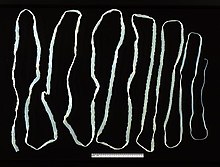Tapeworm
| Cestoda Temporal range: 270–0 Ma |
|
|---|---|
 |
|
| Taenia saginata | |
| Scientific classification | |
| Kingdom: | Animalia |
| Phylum: | Platyhelminthes |
| Class: | Cestoda |
| Subgroups | |
Cestoda (Cestoidea) is a class of parasitic flatworms of the phylum Platyhelminthes. Biologists informally refer to them as cestodes. The best-known species are commonly called tapeworms. All cestodes are parasitic and their life histories vary, but typically they live in the digestive tracts of vertebrates as adults, and often in the bodies of other species of animals as juveniles. Over a thousand species have been described, and all vertebrate species may be parasitised by at least one species of tapeworm.
Humans are subject to infection by several species of tapeworms if they eat undercooked meat such as pork (Taenia solium), beef (T. saginata), and fish (Diphyllobothrium spp.), or if they live in, or eat food prepared in, conditions of poor hygiene (Hymenolepis or Echinococcus species).
T. saginata, the beef tapeworm, can grow up to 20 m (65 ft); the largest species, the whale tapeworm Polygonoporus giganticus, can grow to over 30 m (100 ft). Species using small vertebrates as hosts, though, tend to be small. For example, vole and lemming tapeworms are only 13–240 mm (0.51–9.45 in) in length, and those parasitizing shrews only 0.8–60 mm (0.031–2.362 in).
Tapeworm parasites of vertebrates have a long history: recognizable clusters of cestode eggs, one with a developing larva, have been discovered in fossil feces (coprolites) of a shark dating to the mid- to late Permian, some 270 million years ago.
...
Wikipedia
